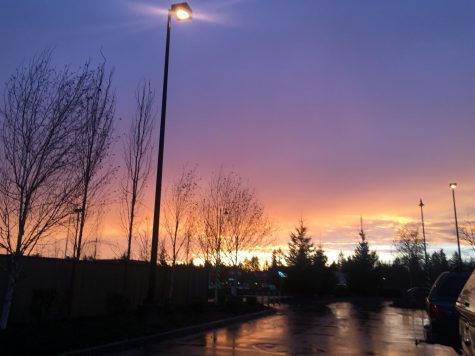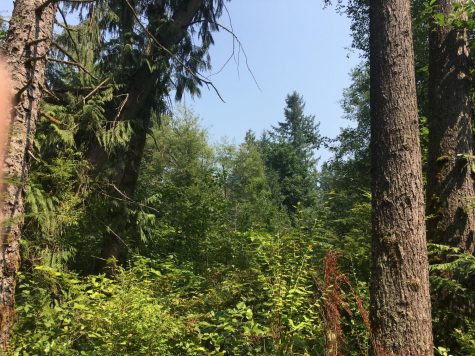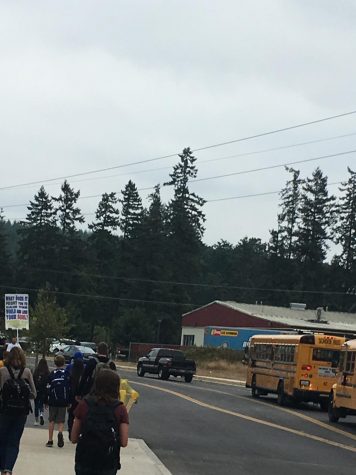Homelessness in Maple Valley
what’s the homeless problem in our city like, and what can we do to fix it?
February 27, 2018
The homeless population of Maple Valley has been surviving through the cold, harsh winter with a lack of shelter or food through countless days and nights over the past few years in the forests and streets of Four Corners, Cherokee Bay and the general Maple Valley area. Because they have nothing else to do and nowhere else to go other than living any way they best can in the streets without the help they need to get back on their feet and get back to living the life they use to have or the one that they want.
Homeless people have been a problem in King County for a long time and it doesn’t show signs of stopping soon, so what are we doing to try and stop it? In 2005, King County passed a bill to increase spending and find the root cause of homelessness, their goal was to cut the homeless population in half by 2015, and although the state saw a drop, King County itself saw a rise of 15% altogether. A lot of this increasing number can be blamed on King County’s always increasing cost of living making it more and more difficult for less financially stable people and families to find a place to live or keep up with house payments. The same is true for the population of homeless living in Maple Valley too poor to afford housing or too down on their luck trapping them into a homeless lifestyle where you have to do anything to get by which can include drug use or being left to scavenging through the streets.

The city of Maple Valley at sunset in November 2017
Jackson Mazziotti a sophomore at Tahoma High School, who’s been a resident of Maple Valley for the past one and a half years after moving here in his 9th-grade year, has already had a fair amount of encounters with the homeless. “I use to see them all the time around the forest they took down to build the high school they had built this little camp with food and tents trying their best to survive in those hot summer months,” said Mazziotti. There aren’t any big homeless shelters around, so this is what they’re left to, taking refuge the best they can, hidden from everyone across the city and doing whatever they can to acquire food, shelter, and other human essentials. The truth is, it’s hard to get any of this without some sort of help from the city, local food banks, and local shelters.
According to the Economist, a news website, across the entire US there are over 500,000 unsheltered homeless living state by state who are living with next to no real shelter and they have to do whatever they can to survive trapped with no money and no home or way to get a job and back on their feet. In Maple Valley, although the number of homeless people isn’t known, it’s still problematic for the city and nothing’s really being done here about it, the small population of homeless here still roam the forests and streets of Maple Valley and it doesn’t seem to be getting better for them or the residents here.

Ryan McCoy, who had been homeless for periods of time before finding a job and place to stay in Utah said “When you’re homeless everyone looks down on you, like you’re subhuman, you’ll rarely get anyone willing to reach out and help you so good luck getting off the street, it makes it really hard to get back on your feet and almost impossible to escape the hole you’re getting thrown into.” With a lot of homeless this is the case and if they aren’t getting help it’s difficult to come back from the bottom and they stay stuck in whatever situation they’re in having to live in shelters or the streets of cities.
Coming from the bottom is hard, but it could be harder in the city of Maple Valley, in a place with more millionaires per capita than Bellevue according to Shawn Martinson a teacher here at Tahoma High School. Maple Valley has a reputation as a good, clean city with nice families and good students. This may affect how the homeless population is treated in the city and treated by people, there are no big nearby shelters or easy access to common necessities with all of this and they’re only able to live in the forests in the area hidden away from everyone and trying to survive however they can. It gets harder and harder to find help and while in some places homelessness is decreasing other places are seeing a spike, such as Seattle, Los Angeles and other places with skyrocketing house prices and cost of living pushing people to the streets.
Jimmy Devos a resident of Maple Valley and a freshman at Tahoma High school has lived his whole life in the area “Living in Maple Valley my whole life, I’ve had a good amount of encounters related to them, sometimes I’ll come across a little piles of cans and old fire pits in the forest and other times I’ll see homeless at night making their way walking around the city, something that worries me more though is in the forests and darker hidden places of Maple Valley you’ll see old used up needles, Maple Valley is full of families and children, and it’s worrying to see stuff like that,” said Devos. Maple Valley is a safe city that doesn’t face the crime and problems many others have to face, but in a place with so many families, it’s something you don’t want to hear and something you wouldn’t want to affect your children. The homeless problem in Maple Valley might not be as bad as it is in other cities across the US and across the state, but it exists and it won’t stop if they don’t get the help they need from the city, food banks, or homeless shelters.

The homeless population is a problem living near the suburban neighborhoods and families of Maple Valley, but there’s no way to solve it without addressing it and finding ways to help first. The city and local schools can help more by looking for ways to solve this such as easier access to food, water, and shelter and the community can help by reaching out and offering help to these people. Because without this help and support things won’t get better for them or the community.


